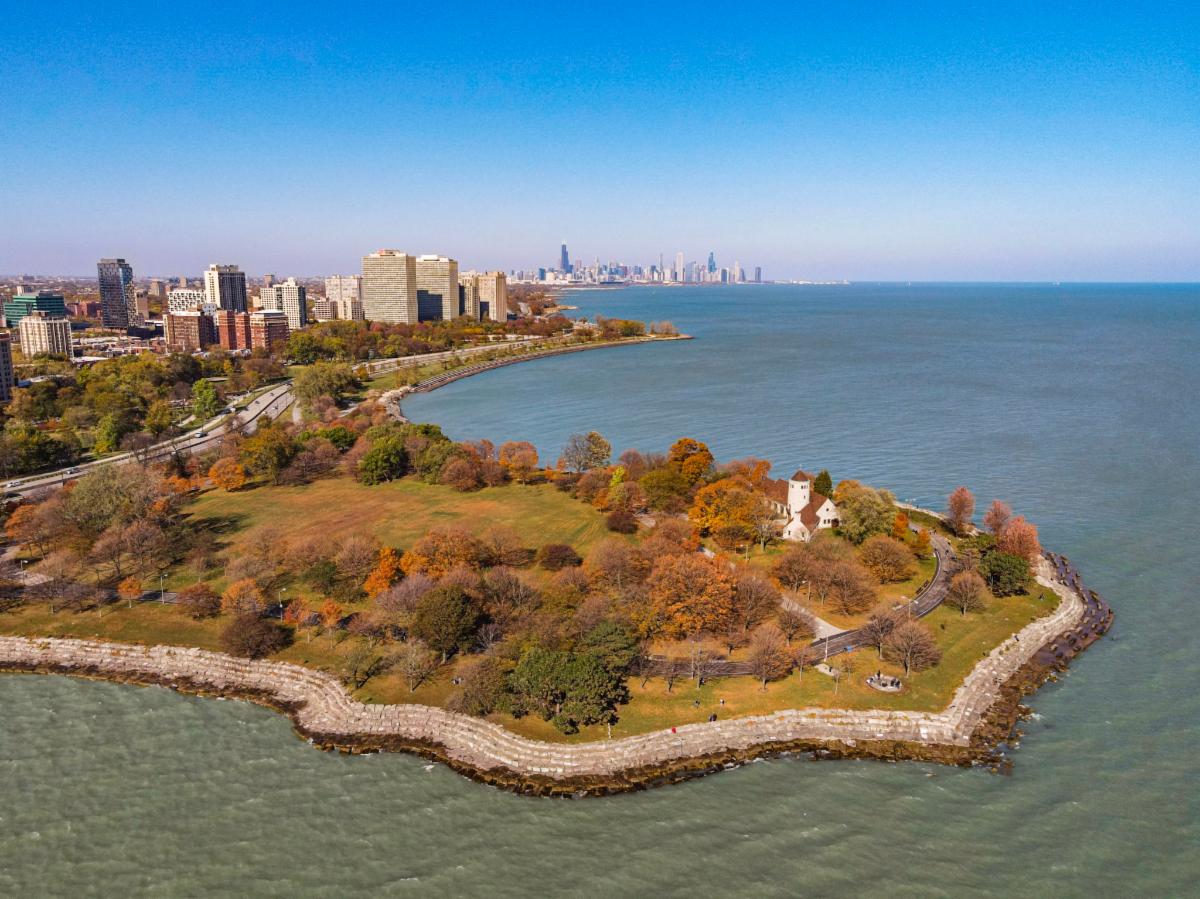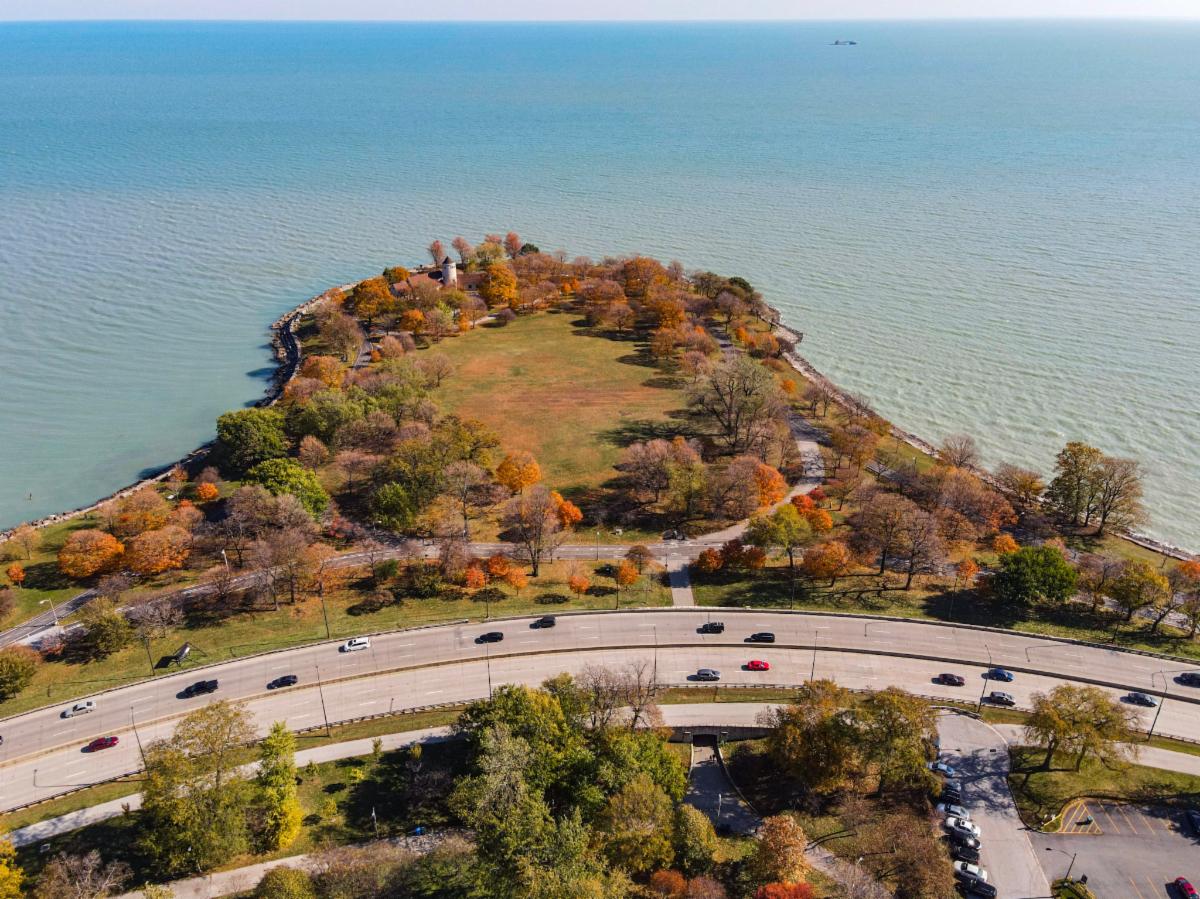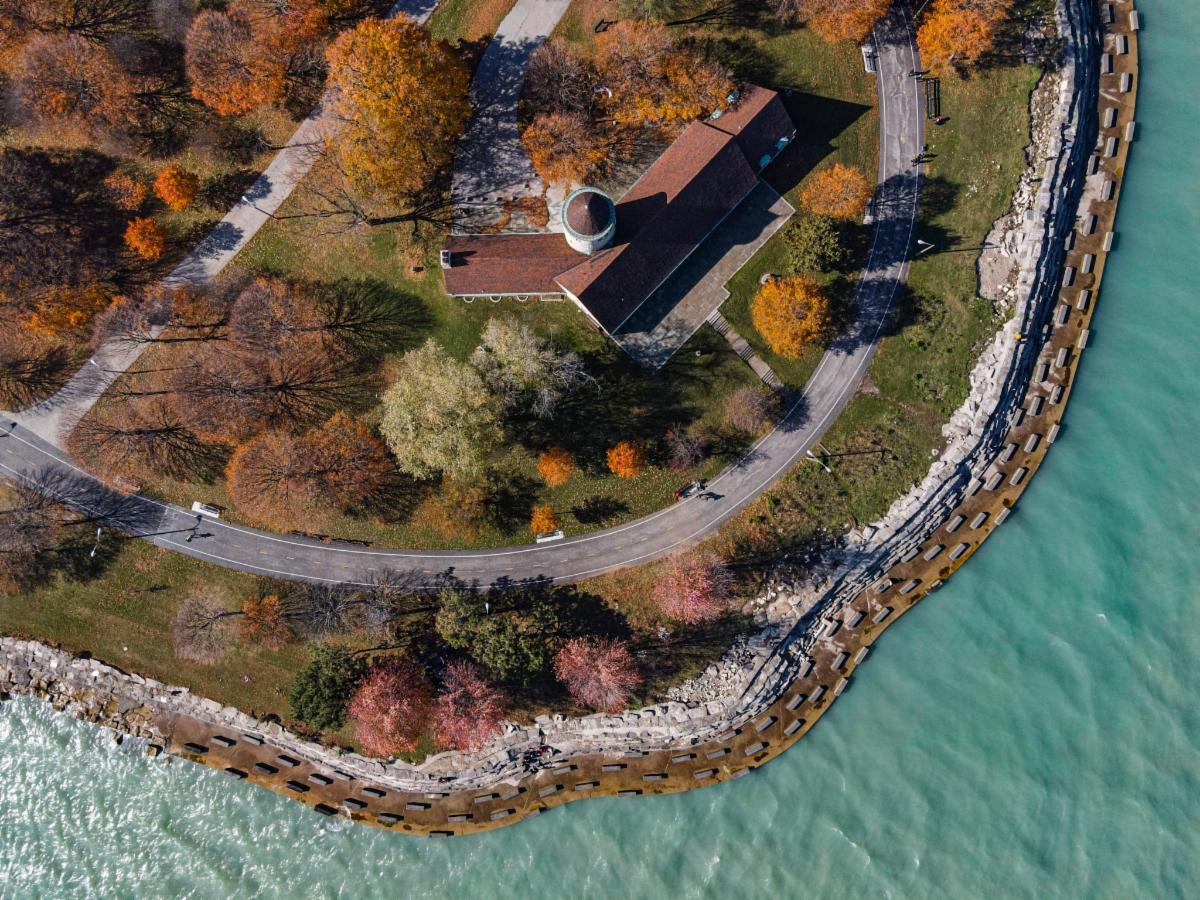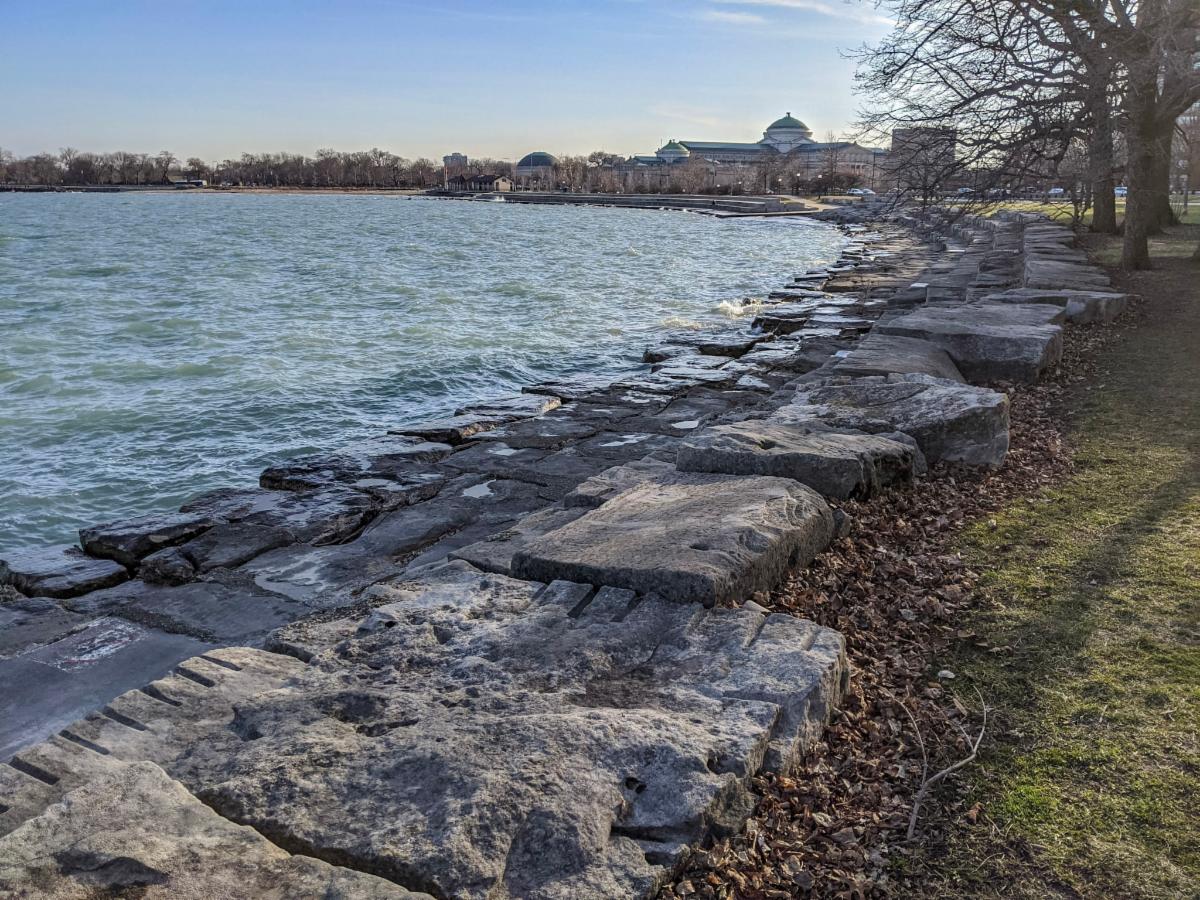



Promontory Point
Alfred Caldwell, 1937, Chicago Lakefront between 54th and 56th Streets
Overview
Last year, Preservation Chicago named the Chicago Lakefront as one of Chicago’s 7 Most Endangered sites, noting the threats facing the city’s many heritage sites along Lake Michigan. This year, we have selected Promontory Point, one of last year’s highlighted lakefront sites, as one of 2022’s 7 Most Endangered due to the continued threat facing The Point’s historic limestone revetment. The City of Chicago, along with the Chicago Park District, intend to replace The Point’s natural limestone with a mass of concrete, destroying not only the historic stepstone revetment, but also the naturalistic aesthetic of this Alfred Caldwell-designed park. This irreversible alteration will adversely affect the open and diverse community culture that has thrived for decades at Promontory Point, moving this historic site further away from its original design and setting a precedent for future unsympathetic alterations.
History
Lake Michigan is Chicago’s own beautiful wilderness, and the lakefront is where this nature and the complex city meet. Burnham Park, a 600-acre expanse of waterfront parkland on the South Side, is one of the city’s finest examples of this. The park was the brainchild of architect and planner Daniel H. Burnham, designer of the 1893 World’s Columbian Exposition, who envisioned a meandering chain of greenspaces that would link the fairgrounds’ remnants with downtown Chicago. An 1896 presentation to members of the South Park Commission including its President, James Ellworth, and other influential Chicagoans, including Marshall Field and George Pullman, helped to first popularize the concept among the city’s decision makers, setting into motion the process to bring the park to fruition.
Burnham, with the help of architect Edward H. Bennett, developed and honed this immense vision over the course of the following decade, incorporating the parkland into his influential 1909 Plan of Chicago. The Plan of Chicago outlined a wide-reaching overhaul of the Chicago landscape, including a boulevard system, ample parkspace, elegant civic structures, and public plazas. As part of this layout, it called for the establishment of cityfront green space buffered by interior lagoons formed by offshore islands along the city’s South Side.
Although the South Park Commission was granted permission by the State of Illinois to move forward with the park’s creation in June 1910, just two weeks after Burnham’s death, the construction process was delayed for years to come. Finally, by the early 1920s, landfilling moved ahead by way of engineering practices that are impressive even by today’s standards. Massive bulkheads made of timber and rocks were installed to form the new park’s eastern boundaries while the parkland itself emerged from the lake by depositing sand, earth, and construction debris between these bulkheads and the already existing shoreline.
To complete this process, protect the land from erosion, and allow people to be near the lake and access the water, eight miles of limestone stepstones were installed along Lake Michigan, managing this meeting place of lakefront wilderness and city parkland. While the interior lagoons and offshore islands outlined in Burnham’s Plan of Chicago were never realized, one small segment did come to exist: Promontory Point, a small peninsula that jutted out from the lakeshore near 55th Street.
By the early 1930s, the landfill process was nearly complete and, following the establishment of the Chicago Park District in 1934, attention soon turned to the construction of new park facilities made possible by funding from the Works Progress Administration (WPA). Under Chicago Park District architect Emanuel Valentine Buchsbaum, plans were prepared for the 55th Street Promontory Pavilion. Designed in an eclectic French Revival style, the building is faced with Lannon stone and features a prominent tower with a conical roof. The Pavilion’s construction occurred simultaneously with the final grading and planning of Promontory Point itself and, to carry out this considerable task, the Chicago Park District selected Alfred Caldwell, one of their junior staff members.
Underappreciated for decades, Caldwell today is acknowledged as one of the greatest Prairie School landscape designers of all time. His distinguished work still exists outside of Promontory Point, most notably at Lincoln Park’s Alfred Caldwell Lily Pool which is today a Chicago Landmark, a National Historic Landmark, and has been entered into the National Register of Historic Places. Caldwell also worked closely with famed landscape architect Jens Jensen for years before coming on as a Chicago Park District employee after facing financial difficulties in the wake of the Great Depression.
The Point’s pavilion had already been designed by the time Caldwell was brought on, so it bears none of his Prairie School signature, in contrast to the heavily Prairie School landscape he would soon bring to The Point’s untouched terrain. The Point’s main meadow was adorned with native shrubs and foliage while gaps were laid out that allowed vistas of the water’s expanse, connecting the beauty of Lake Michigan with the man-made engineering of Promontory Point. Curved walkways around The Point’s perimeter led park visitors along its outer edge, granting them views of additional native plants and access to the limestone revetments leading down to the water.
Even before its completion, Promontory Point was an immediate success. Much as it is today, The Point quickly became a popular gathering spot for Chicagoans. The YWCA, YMCA, and University of Chicago student organizations, among many others, found a home at Promontory Point, drawn there by comfortable recreational space. By 1948, the park had officially earned the name Promontory Point, although the name’s origin has never been entirely confirmed. The Point continued to be an important site in Chicago for decades to come; in particular, the park played a prominent role during the Cold War when Nike Missile radar towers were erected along the park’s southern shore in 1953. After years of protest, the facilities were demolished in 1971.
In the 1980s, fear of damage to Lake Shore Drive from then-rising lake levels prompted the City to begin replacing the limestone revetments with massive concrete and steel structures everywhere along the Chicago lakefront, except Promontory Point. When the City’s attention turned to Promontory Point in the early 2000s, the community, with the help of then-Senator Barack Obama, resisted the demolition so that, in 2006, the City’s concrete project was stalled. Still, plans persist from the City and the Chicago Park District to remove these revetments once and for all. Today, the historic revetment at Promontory Point is all that is left of a once-eight mile long stretch of beautiful limestone transitions between nature and the city.
Threats
Even after 84 years, the existing limestone revetment at Promontory Point continues to protect the parkland behind it, serving as a beloved place of recreation for park visitors. The revetment does, however, need major repair as well as rehabilitation to allow better access for all to the lake and to the water. Twenty years ago, the community paid for its own independent engineers, architects, and mediators, and discovered that preservation, repair, and rehabilitation of The Point’s historic limestone revetment is feasible and cost-effective. Although a preservation approach to repairs and rehabilitation is still viable, the City has recently revived its plan to demolish the historic limestone revetment and to reconstruct a concrete revetment in its place.
Recommendations
Preservation Chicago calls on the City of Chicago and the Chicago Park District to consent to the designation of Promontory Point as a Chicago Landmark, decisively ensuring the protection of The Point’s historic revetments for all time. In 2018, Promontory Point was put on the National Register of Historic Places, making it more difficult to destroy the historic revetment – but not impossible. Designating Promontory Point an official Chicago Landmark, and specifically highlighting The Point’s limestone revetments as an integral part of the designation, would make demolition almost impossible and would make certain that repair and rehabilitation of The Point’s revetment preserves its historic integrity and beauty. Fifth Ward Alderman Leslie Hairston has supported preservation in the community’s fight to save The Point since 1996. U.S. Congresswoman Robin Kelly and State Senator Robert Peters have also recently spoken out for preservation at The Point.
Preservation Chicago sees no reason for demolition of the original structures and does not support the use of textured concrete as a substitute for the existing limestone. We also support the Promontory Point Conservancy’s wish to hire its own independent engineers, architects, and community organizers to prove once more that preservation is doable, cost-effective and desirable. We are confident that this is an opportunity for the City to work cooperatively with a passionate community to find the best preservation plan to protect and preserve a beloved public landmark. In doing so, they can enhance lake access with creative ADA compliance, avoid environmental hazards by repositioning the original limestone material instead of concrete, and invest equitably in South Side parks overall. Preservation Chicago urgently recommends the City of Chicago and the Chicago Parks District seize this opportunity to preserve the remaining original features of this historic park.


